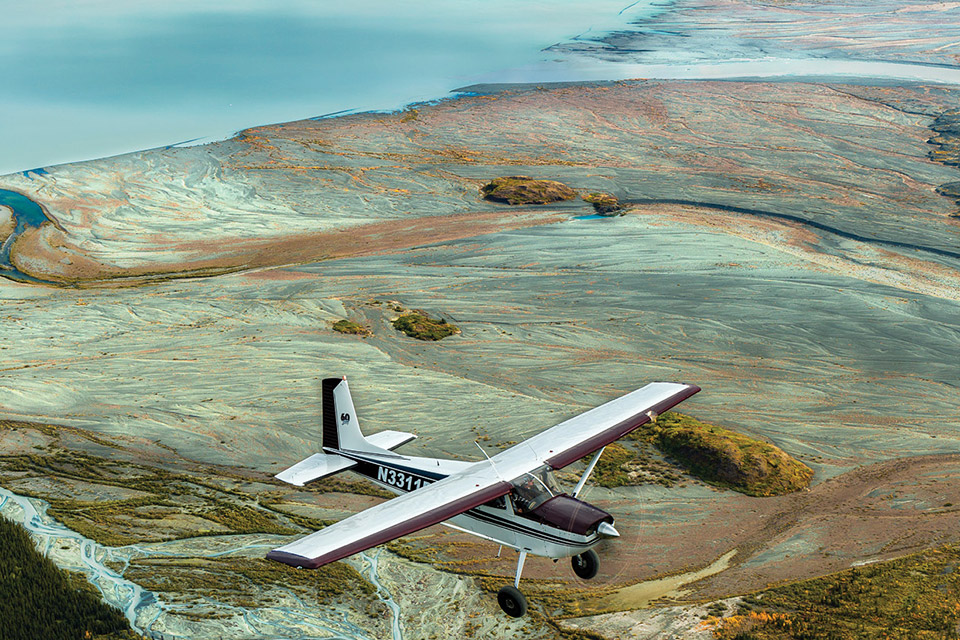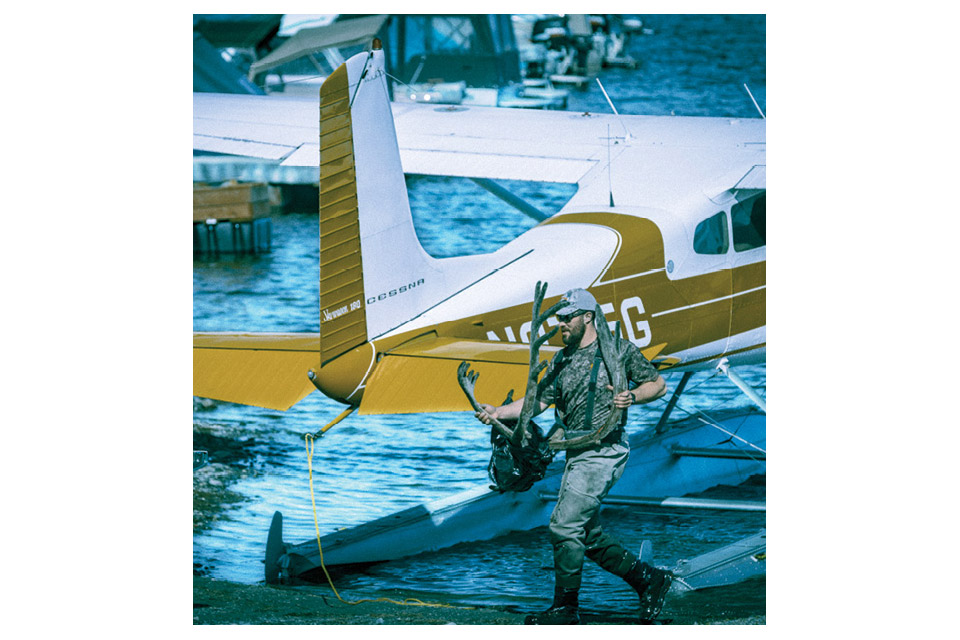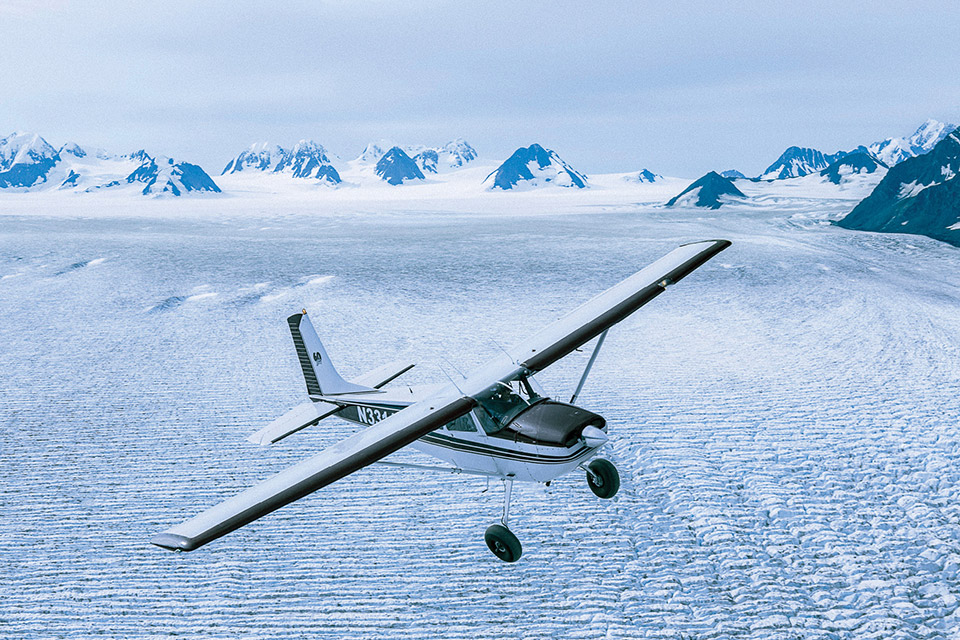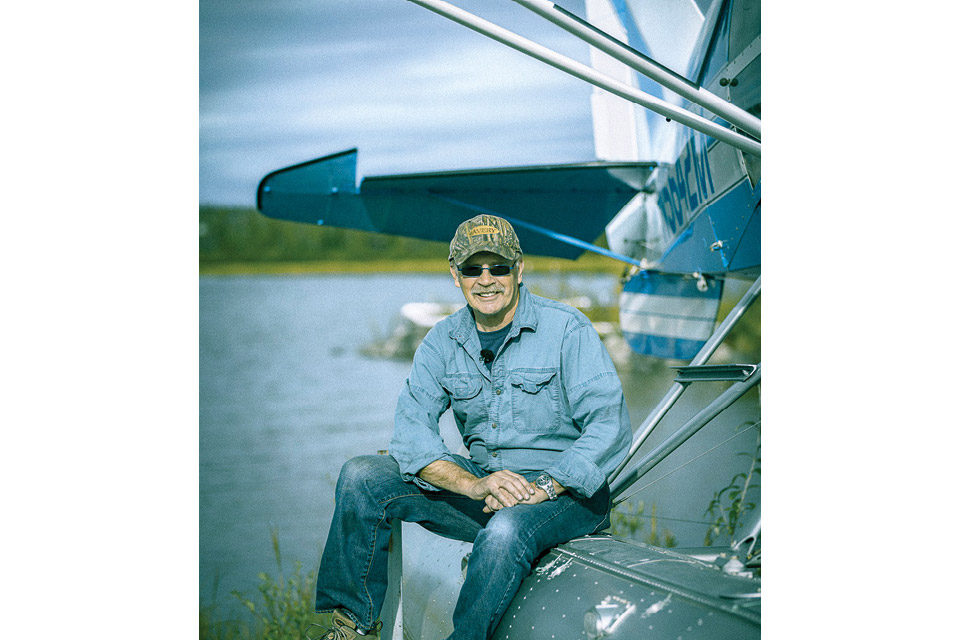Getaways: Copper River Basin
Great escape
General aviation at its best in Alaska
I dip a wing on the Cessna 175 to allow a bald eagle to pass by as we skim over Lake Louise, a mile from where the pavement ends. The only ripples on the 10-mile-long lake are the V-shaped wakes from majestic trumpeter swans and the occasional loon. Otherwise, the water reflects the Alphabet Hills, the foothills a prelude to the snow-capped Alaska Range farther north. In between and for miles east and west, there is no pavement. Here, general aviation airplanes are the pickup trucks and SUVs of everyday life.
Late August is hunting season. Father-and-son pilots Mark and Robert Monfore idle their Cessna 180 floatplane into the seaplane base at the southern edge of Lake Louise to offload quarters of the caribou Robert shot miles to the north. A new refrigerator in a box shows up on the dock, where it’s loaded on a boat headed to a cabin up north. With no roads north from here, boats and airplanes are the way to move people, gear, and supplies. Soon, though, the ice will freeze four feet thick, and airplanes become the only means of practical transportation.
“Sure, it gets cold,” Dennis Oakland says with a shrug, “but the winter weather is mostly sunny. We get around OK.” Oakland, proprietor of the Lake Louise seaplane base and marina and Evergreen Lodge, has a knack for understatement. Cold here means minus-40 to minus-50 degrees Fahrenheit. A pilot and retired cop, he keeps the operation going while also spending two weeks a month “on the slope,” working aviation and security matters on the North Slope oil wells.
Similarly, Galen Gaunt has to move around to make a go of it in rural Alaska. Gaunt is an airline transport pilot and an airframe and powerplant mechanic with inspection authorization. He lives in Glennallen, about a 45-minute drive southeast of the Evergreen Lodge. Gaunt carts his mechanic’s tools from Anchorage and Palmer to Glennallen and beyond, working on airplanes and occasionally flight instructing. Like Oakland, Gaunt is not an Alaska native, but they’ve been in the forty-ninth state for decades and neither would consider living—or flying—anywhere else.
has real meaning and necessity. It turns out Lake Louise is a great spot from which to explore the entire Copper River Basin. Hemmed in on all sides by mountains, the basin is relatively accessible from the south, near the Chugach Range. The Talkeetnas form a wall to the west, Alaska Range to the north, and the Wrangells to the east—all 50 to 80 nautical miles away from the lake. As Gaunt points out, the weather may be poor in one direction or another, but most likely there’s one area that is flyable. This makes hunting, fishing, camping, and exploring available most days.
The 3,000 feet of gravel at the Lake Louise airport might as well be pavement, it’s so compacted. Oakland’s Cessna 175 is the only airplane based there. “It’s like they built the airport just for me,” he jokes. But like all the airports throughout the state, this one is an important part of the transportation infrastructure. There are no services at the airport, but Oakland plans to offer fuel from a portable tank on his truck. He already has avgas at the seaplane base.
With Gaunt in the right seat, I climb the 175 away from the smooth surface for a trip around the lake. Cabins dot the shoreline, all of them potential customers for Oakland’s barge, which can lug 14 tons of building materials, gear, and even a bulldozer to the sites for construction, or just everyday supplies. Tall, skinny spruce trees cover the mostly flat landscape for miles, their size stunted by the permafrost. Unable to soak in, water pools into ponds everywhere. Larger lakes abound. Although they mostly look alike to this rookie, Gaunt and the other local pilots know them all by name.
Company soon arrives as Joe Pendergrass and Danny Davidson swoop in, both in their Cessna 180s. The pair—along with one of Pendergrass’s passengers, Bob Elliott—routinely fly as part of the Iditarod Air Force, the official aerial support team for the iconic annual sled dog race from Anchorage to Nome. Dogs, dog food, water, supplies, mushers, race officials, media, and medical supplies move along the 1,000-mile race course via general aviation airplanes.
In case you’re wondering, the answer is 16: the number of sled dogs you can get into a Cessna 180, Elliott confirms. His first year he proudly managed to get eight into his Skywagon. “It was full, I thought,” says Elliott. An experienced Iditarod pilot came along and put in eight more—an entire team. “They’re mostly well behaved,” he says of the many times he has since flown dogs. “Every once in a while one of them gets an attitude and starts to harass the others.” A couple of seconds of negative Gs quiets them right down.
Down the river. Pendergrass’s Skywagon leads us southeast as we explore the Copper River Basin. The region gets its name from the large amounts of copper in the area. The river itself takes on a green hue, the color of an oxidized copper roof. The river churns and twists past the Wrangell Mountains. As it continues south to its massive delta at the Gulf of Alaska, we dodge slightly left to pick up the Chitina River, headed for the remote mining town of McCarthy.
The town is mostly abandoned, although its gravel airport just down the valley is anything but. Flightseeing operators ply the area, giving tourists a bird’s-eye view of the Kennicott and Root glaciers. As we admire the vista from the ramp, de Havilland Beavers, Cessna 206s, and even a Piper Navajo taxi by, eager and slightly nervous faces pressed to the windows. The tourists return our enthusiastic waves. The wind is calm, the air smooth.
Pendergrass graciously allows me to fly his 180 and we take off to explore the glaciers ourselves, the 175 just ahead. Mindful that we are inside Wrangell-St. Elias National Park, we climb to an appropriate altitude and form up over the glacier for some air-to-air photography and video. At 13.2 million acres, Wrangell-St. Elias is larger than Yellowstone and Yosemite national parks combined—and combined with Switzerland. With its multiple airports and lodges scattered around, a pilot could spend weeks just exploring this corner of Alaska.
But, alas, there is a limit to our fuel, and we head back toward Evergreen Lodge at Lake Louise. Anxious to take maximum advantage of the remarkably cooperative weather, we poke along, stopping to explore the nooks and crannies of the Chitina and Copper rivers and their valleys. We have an eye out for game animals, finally spotting a moose and her calf loafing in a pond. She pays us no mind.
The next morning we waste no time launching the 175 and Pendergrass’ 180 to explore the Tazlina Glacier to the south. Although there’s barely a breath of wind, we expect some turbulence as we fly south up the northward-flowing glacier. Hugging the rocky walls, we experience only calm air. The river of ice looks like a superhighway carved into the mountainscape. We make a U-turn and head north, mesmerized by the deep crevasses below. The glacier feeds Tazlina Lake, which this day is the same green as the Copper River.
A left turn has us nearly paralleling the Glenn Highway, the main road between Anchorage and the Copper River Basin. The forests below seem to go on forever, interrupted only by mountain peaks that climb steeply from the valleys. This week they’ve become adorned with blazing golds and reds from fireweed and lichen. Although it’s not yet September, autumn has arrived here. “The termination dust will be along soon,” assures Oakland. He’s correct—in 48 hours this valley will be snow-covered, the first snow indicating the termination of autumn.
We pass Gunsight Mountain, known for its notch at the summit that looks like, well, a gunsight. Our destination is Sheep Mountain, farther down the Matanuska River valley. Sheep Mountain Airport is tucked up against the mountain, with a lodge at the eastern end—just past the Volvo junkyard, as we discover. After admiring the mountain views from the dirt strip, we launch and continue eastward a few miles to fly by Sheep Mountain. Apparently the local critters read the signs, because, sure enough, Dall sheep are perched on the side of the steep incline, nonchalantly watching us motor by.
Our weather luck runs out the next day as drenching rains cascade off of Oakland’s Maule on floats at Lake Louise. We view the downpours from Evergreen Lodge’s comfortable dining room. The Internet access never blinks, even here in the hinterlands, and we use the day to catch up on work.
With bearskin rugs hung on the pine-paneled walls, the lodge looks like something out of an L.L.Bean catalog. The main lodge includes four comfortable guest rooms. Four “rustic” one-room cabins on the property offer a rougher existence, although with queen-size beds, you’re not exactly camping. You will need to come to the main lodge to use the restrooms and showers. The staff serves up breakfast to guests, but you’re generally on your own for the rest of the meals, although a grill and condiments are provided. Guests can walk to nearby Lake Louise Lodge for dinner.
During our lull in flying, we catch up with Jim Ellis, a Cessna 185 pilot from Wasilla who has been retired from his flying job with the U.S. Fish and Wildlife Service for 24 days. “I’m kind of bored already,” he confesses. Over his 14,000 hours he, too, has flown with the Iditarod Air Force, but mostly he has been involved in various game tagging and tracking exercises—everything from geese to caribou and elk. He’s checked out in every airplane model the service owns in Alaska—floats, wheels, skis. And although he has an instrument rating and has flown lots of charter operations, he’s never filed an IFR flight plan. “It’s just not something I’ve really needed,” he says matter-of-factly.
So far on our Alaska flying adventure we’ve managed to avoid landing on pavement—only gravel and dirt. I’m itching to try out the water when Bert Gore comes by to exercise his Cessna 206 on straight floats. I’ve been eyeing it all week, tied down at the seaplane base just below the lodge’s big deck. Gore, a retired veterinarian, has been busy this week checking cows at the Alaska State Fair in Palmer, his hometown. He’s lived a James Herriot sort of life, managing a big and small animal practice in rural Alaska. He and his wife moved to Alaska from Texas in 1969, “just to try it out.” They never left.
Gore’s 206 is his means to transport family to his cabin on remote Crosswind Lake, miles from the nearest road. En route to the cabin, he shows us dozens of other lakes in the region, some with a few cabins, most with none. Salmon swim up the rivers that link the lakes, making for remarkable fishing for the prized Copper River salmon. The state drops baby salmon by the hundreds of thousands from modified agplanes into the region’s lakes. A stiff breeze keeps us from landing on Crosswind Lake, but we see Gore’s cabin—no power, no running water, just a place to escape from it all for a few weeks a year.
Back at Lake Louise we nudge the Stationair into the protected cove near the lodge. A 25-knot wind is producing whitecaps out on the lake. With his hip boots already on, Gore slips into the water and quickly secures the Cessna to the dock.
And so ends our GA flying in Alaska—this trip. The next time we will allow more time. For it seems that around every corner of this vast state there is a postcard setting yet to be explored, and a GA airplane on tundra tires, floats, or skis is the only way to do it right.
Email [email protected]















